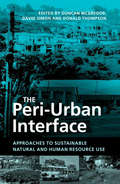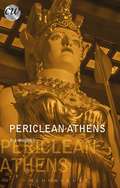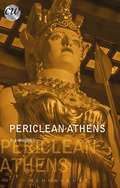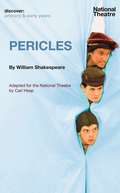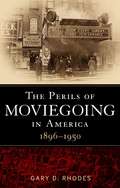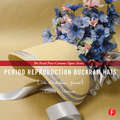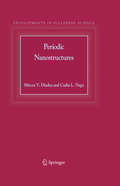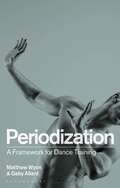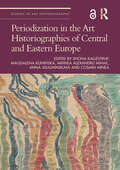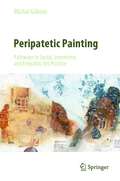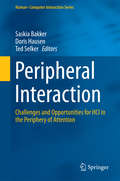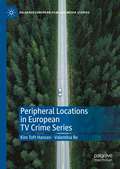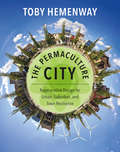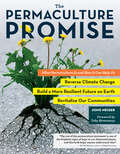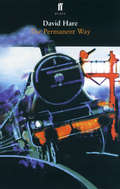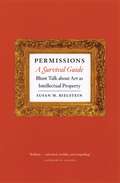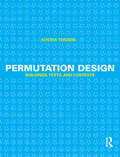- Table View
- List View
The Peri-Urban Interface: Approaches to Sustainable Natural and Human Resource Use
by Duncan McGregor David SimonPeri-urban interfaces - the zones where urban and rural areas meet - suffer from the greatest problems to humans caused by rapid urbanization, including intense pressures on resources, slum formation, lack of adequate services such as water and sanitation, poor planning and degradation of farmland. These areas, home to hundreds of millions of people, face unique problems and need distinctive and innovative approaches and solutions. This book, authored by top researchers and practitioners, covers the full breadth and depth of the impacts of rapid urbanization on livelihoods, poverty and resources in the peri-urban zones in diverse African, Asian, Latin American and Caribbean contexts. Topics include peri-urban resource sustainability, ecosystems and societies and environmental changes in peri-urban zones. Rich case studies cover production systems and livelihoods including the impacts of irrigated vegetable production, horticulture, dairy enterprises, waste-fed fisheries and pastoral livelihoods. Also addressed are planning and development issues in the peri-urban interface including the difficulty in achieving sustainability, conflict and cooperation over resources, and a fresh look at the relationship between people and their environment. The final part of the book presents policies and strategies for promoting and measuring sustainability in peri-urban zones including community-based waste management, the co-management of watersheds and empowerment of the poor. This book is the most comprehensive examination of the challenges and solutions facing the people and environments of peri-urban zones and is essential reading for all practitioners, students and academics in geography and development.
Periclean Athens (Classical World)
by P. J. RhodesIn the second and third quarters of the fifth century BC, when Athens became both politically and culturally dominant in the Greek world, Pericles was the leading figure in the city's public life. At this time Athens developed an empire of a kind which no Greek city had had before, and its politics were reshaped by the new institution of democracy.These changes inspired religious developments, while the sophists revolutionised philosophy, analysed human affairs in human terms, and Athenian tragedy became the principal Greek poetic form. This volume's illustrations further show the numerous artistic and sculptural developments in Pericles' time, as the building programmes attracted architects, builders and sculptors to Athens, and Athenian red-figure pottery reached new heights of skill in the scenes painted on it.This concise and accessible introduction guides students through the key aspects of this most-studied period of ancient Greek history, focusing on the major developments, political and cultural, that took place in Pericles' time.
Periclean Athens (Classical World)
by Pj RhodesIn the second and third quarters of the fifth century BC, when Athens became both politically and culturally dominant in the Greek world, Pericles was the leading figure in the city's public life. At this time Athens developed an empire of a kind which no Greek city had had before, and its politics were reshaped by the new institution of democracy.These changes inspired religious developments, while the sophists revolutionised philosophy, analysed human affairs in human terms, and Athenian tragedy became the principal Greek poetic form. This volume's illustrations further show the numerous artistic and sculptural developments in Pericles' time, as the building programmes attracted architects, builders and sculptors to Athens, and Athenian red-figure pottery reached new heights of skill in the scenes painted on it.This concise and accessible introduction guides students through the key aspects of this most-studied period of ancient Greek history, focusing on the major developments, political and cultural, that took place in Pericles' time.
Pericles: With The Story Of The Prince Of Tyre... . (Oberon Plays for Young People)
by William Shakespeare Carl HeapAdapted for The National Theatre by Carl Heap 'The world to me is like a lasting storm' An exciting tale of shipwrecks and magic, villains and heroes, and a child's fight for survival in a foreign land. Join Pericles on his epic travels of adventure and discovery. Primary Classics, produced by the National Theatre's Discover programme, aims to introduce children aged 7 to 11 to Shakespeare. This version of Pericles, adapted and originally directed by Carl Heap, preserves the core of Shakespeare's plot, retains the original langauge, yet is presented very much with the target age group in mind. Carl Heap's introduction will help readers, teachers and practitioners alike to imagine or produce their own version.
The Perils of Moviegoing in America: 1896-1950
by Gary D. RhodesDuring the first fifty years of the American cinema, the act of going to the movies was a risky process, fraught with a number of possible physical and moral dangers. Film fires were rampant, claiming many lives, as were movie theatre robberies, which became particularly common during the Great Depression. Labor disputes provoked a large number of movie theatre bombings, while low-level criminals like murderers, molesters, and prostitutes plied their trades in the darkened auditoriums. That was all in addition to the spread of disease, both real (as in the case of influenza) and imagined ("movie eyestrain"). Audiences also confronted an array of perceived moral dangers. Blue Laws prohibited Sunday film screenings, though theatres ignored them in many areas, sometimes resulting in the arrests of entire audiences. Movie theatre lotteries became another problem, condemned by politicians and clergymen throughout America for being immoral gambling. The Perils of Moviegoing in America: 1896-1950 provides the first history of the many threats that faced film audiences, threats which claimed hundreds, if not thousands, of lives.
The Perils of Moviegoing in America: 1896-1950
by Gary D. RhodesDuring the first fifty years of the American cinema, the act of going to the movies was a risky process, fraught with a number of possible physical and moral dangers. Film fires were rampant, claiming many lives, as were movie theatre robberies, which became particularly common during the Great Depression. Labor disputes provoked a large number of movie theatre bombings, while low-level criminals like murderers, molesters, and prostitutes plied their trades in the darkened auditoriums. That was all in addition to the spread of disease, both real (as in the case of influenza) and imagined ("movie eyestrain"). Audiences also confronted an array of perceived moral dangers. Blue Laws prohibited Sunday film screenings, though theatres ignored them in many areas, sometimes resulting in the arrests of entire audiences. Movie theatre lotteries became another problem, condemned by politicians and clergymen throughout America for being immoral gambling. The Perils of Moviegoing in America: 1896-1950 provides the first history of the many threats that faced film audiences, threats which claimed hundreds, if not thousands, of lives.
Period Reproduction Buckram Hats: The Costumer’s Guide (The Focal Press Costume Topics Series)
by Crystal G. HermanWhether you’re in a professional or a community theatre, part of a historical re-enactment, or teaching costume construction, a well-made hat provides a much-needed finishing touch to a costume. Period Reproduction Buckram Hats: The Costumer’s Guidebook is your one-stop resource for learning how to recreate historically accurate buckram hats. Each chapter is devoted to the construction of a particular hat, beginning with a historical image and followed by an list of the exact amount of fabric, tools, and materials needed and the estimated time to complete the construction. Every chapter contains a brief historical background on each hat, a pattern, step-by-step instructions, process photographs, and ideas for altering the pattern to fit your unique production. This book not only provides instruction for the exacting reproduction of historic hats, but it also guides and encourages you to alter patterns and techniques to create your own designs. The final chapters outline general millinery principles that can be applied to almost any hat, allowing you to customize your project.
Period Reproduction Buckram Hats: The Costumer’s Guide (The Focal Press Costume Topics Series)
by Crystal G. HermanWhether you’re in a professional or a community theatre, part of a historical re-enactment, or teaching costume construction, a well-made hat provides a much-needed finishing touch to a costume. Period Reproduction Buckram Hats: The Costumer’s Guidebook is your one-stop resource for learning how to recreate historically accurate buckram hats. Each chapter is devoted to the construction of a particular hat, beginning with a historical image and followed by an list of the exact amount of fabric, tools, and materials needed and the estimated time to complete the construction. Every chapter contains a brief historical background on each hat, a pattern, step-by-step instructions, process photographs, and ideas for altering the pattern to fit your unique production. This book not only provides instruction for the exacting reproduction of historic hats, but it also guides and encourages you to alter patterns and techniques to create your own designs. The final chapters outline general millinery principles that can be applied to almost any hat, allowing you to customize your project.
Period Rooms: Von Zeitreisen und imaginierten Begegnungen im Museum (Edition Museum #89)
by Stefan KrämerPeriod Rooms können Museen offener, diverser und inklusiver machen. Wie kann das enorme Potenzial dieses heute fast vergessenen Ausstellungsformats genutzt werden? Lange Zeit als altbacken und rückständig abgetan, entdecken Künstler*innen und Kurator*innen Period Rooms wieder, entstauben das Konzept und entwickeln es kreativ weiter. Stefan Krämer liefert die erste systematische Analyse dieser aktuellen Ansätze. Er schließt damit eine Lücke in der museumsgeschichtlichen Forschung und rückt zugleich eine spezifische Form des Displays in den Fokus, durch dessen Einsatz Museen zu Orten multiperspektivischer Verhandlung transformiert werden können.
Periodic Nanostructures (Developments in Fullerene Science #7)
by Mircea V. Diudea Csaba L. NagyThese tiny structures could offer architectural designs for the cities of the future. The authors explore the foam-like carbon structures, which relate to ‘schwarzites’ and which are infinite periodic minimal surfaces of negative curvature. They show that the periodicity of close repeat units of such structures is evident not only in these formations but also in all of the carbon allotropes. The text provides literature and data on the field of nanostructure periodicity and the authors’ own results on nanostructure building and energy calculations.
Periodization: A Framework for Dance Training
by Matthew Wyon Gaby AllardThe training of elite dancers has not changed in the last 60 years; it is often only those that have survived the training that go on to have a career, not necessarily the most talented. It is time to challenge and change how we train tomorrow's professional dancers. This book brings you the reasons why and all tools to implement change.10 years ago, Matthew Wyon and Gaby Allard introduced a new pedagogical approach to training vocational dancers: Periodization. This ground-breaking new methodology provides an adaptable framework to optimise training - it's goal-focused, fits to performance schedules, and is highly sustainable for the dancer. It is the future.For the first time, Wyon and Allard have put their discoveries to paper. Periodization provides clear context to why change is needed, and explores the theoretical underpinnings of this new approach and how it can be effectively applied to a dance environment.
Periodization: A Framework for Dance Training
by Matthew Wyon Gaby AllardThe training of elite dancers has not changed in the last 60 years; it is often only those that have survived the training that go on to have a career, not necessarily the most talented. It is time to challenge and change how we train tomorrow's professional dancers. This book brings you the reasons why and all tools to implement change.10 years ago, Matthew Wyon and Gaby Allard introduced a new pedagogical approach to training vocational dancers: Periodization. This ground-breaking new methodology provides an adaptable framework to optimise training - it's goal-focused, fits to performance schedules, and is highly sustainable for the dancer. It is the future.For the first time, Wyon and Allard have put their discoveries to paper. Periodization provides clear context to why change is needed, and explores the theoretical underpinnings of this new approach and how it can be effectively applied to a dance environment.
Periodization in the Art Historiographies of Central and Eastern Europe (Studies in Art Historiography)
by Shona Kallestrup Magdalena Kuni 324 Ska Mihail Alexandru Mihnea Anna Adashinskaya Cosmin MineaThis volume critically investigates how art historians writing about Central and Eastern Europe in the late nineteenth and early twentieth centuries engaged with periodization. At the heart of much of their writing lay the ideological project of nation-building. Hence discourses around periodization – such as the mythicizing of certain periods, the invention of historical continuity and the assertion of national specificity – contributed strongly to identity construction. Central to the book’s approach is a transnational exploration of how the art histories of the region not only interacted with established Western periodizations but also resonated and ‘entangled’ with each other. In their efforts to develop more sympathetic frameworks that refined, ignored or hybridized Western models, they sought to overcome the centre–periphery paradigm which equated distance from the centre with temporal belatedness and artistic backwardness. The book thus demonstrates that the concept of periodization is far from neutral or strictly descriptive, and that its use in art history needs to be reconsidered. Bringing together a broad range of scholars from different European institutions, the volume offers a unique new perspective on Central and Eastern European art historiography. It will be of interest to scholars working in art history, historiography and European studies.
Periodization in the Art Historiographies of Central and Eastern Europe (Studies in Art Historiography)
by Shona Kallestrup Magdalena Kunińska Mihnea Alexandru Mihail Anna Adashinskaya Cosmin MineaThis volume critically investigates how art historians writing about Central and Eastern Europe in the late nineteenth and early twentieth centuries engaged with periodization. At the heart of much of their writing lay the ideological project of nation-building. Hence discourses around periodization – such as the mythicizing of certain periods, the invention of historical continuity and the assertion of national specificity – contributed strongly to identity construction. Central to the book’s approach is a transnational exploration of how the art histories of the region not only interacted with established Western periodizations but also resonated and ‘entangled’ with each other. In their efforts to develop more sympathetic frameworks that refined, ignored or hybridized Western models, they sought to overcome the centre–periphery paradigm which equated distance from the centre with temporal belatedness and artistic backwardness. The book thus demonstrates that the concept of periodization is far from neutral or strictly descriptive, and that its use in art history needs to be reconsidered. Bringing together a broad range of scholars from different European institutions, the volume offers a unique new perspective on Central and Eastern European art historiography. It will be of interest to scholars working in art history, historiography and European studies.
Peripatetic Painting: Pathways in Social, Immersive, and Empathic Art Practice
by Michal GliksonThis book documents the practice-led research of painting as a peripatetic art practice through travel and transient life in Australia, India, and Pakistan. Crossing disciplines of Art, Applied Anthropology, and Cultural Geography, painting is explored as a way of negotiating the uncertainties inherent in cross-cultural journeys, and the possibility of connecting with others in their lifeworlds. The ways of navigating and of making that support creativity in the field are identified, as are the multifarious conditions of the field in view of how these shaped painting, and ultimately, the consciousness of the artist through possibilities for empathy, advocacy, and activism. The book includes many images that illustrate the form which painting took in the field and the techniques employed to create these. Interactive links in the eBook edition enable the reader to view documentary films about subjects with whom the artist worked, and that illustrate the field and conditions of making. Throughout the book the reader may also engage with virtual tours of the Australindopak Archive as the art work generated by this research.
Peripheral Interaction: Challenges and Opportunities for HCI in the Periphery of Attention (Human–Computer Interaction Series #0)
by Saskia Bakker Doris Hausen Ted SelkerComputing devices have become ever more present in our everyday environments, however embedding these technologies into our routines has remained a challenge. This book explores the novel theory of peripheral interaction to rectify this. This theory examines how interactive systems can be developed in such a way to allow people to seamlessly interact with their computer devices, but only focus on them at relevant times, building on the way in which people effortlessly divide their attention over several everyday activities in day to day life. Capturing the current state of the art within the field, this book explores the history and foundational theories of peripheral interaction, discusses novel interactive styles suitable for peripheral interaction, addresses different application domains which can benefit from peripheral interaction and presents visions of how these developments can have a positive impact on our future lives. As such, this book’s aim is to contribute to research and practice in fields such as human-computer interaction, ubiquitous computing and Internet of Things, a view on how interactive technology could be redesigned to form a meaningful, yet unobtrusive part of people’s everyday lives. Peripheral Interaction will be highly beneficial to researchers and designers alike in areas such as HCI, Ergonomics and Interaction Design.
Peripheral Locations in European TV Crime Series (Palgrave European Film and Media Studies)
by Kim Toft Hansen Valentina ReThis book is a comprehensive study of peripheral locations in contemporary European TV crime series. Ambitiously, it covers the complete geography of Europe, and offers a nuanced image of a changing, dynamic, and unfinished continent. The chapters include analyses of the practical, creative approach to producing crime series in European peripheries and rural areas, evaluating a continent marked by an internal crisis between urban and rural Europe. The study includes readings of crime series such as Shetland, Bitter Daisies, Trom, Pagan Peak, and The Border, but presents such representative cases within broader tendencies on the European TV market, including challenges from streaming services, the influence of Nordic Noir, and changes within the cognitive geography of Europe. The authors position peripheral European crime series in a complex relationship between universal appeal and local recognisability and offer a comprehensive theoretical approach to the aesthetics of peripherality. Grounded in desktop production studies, the book presents an original scholarly approach to analysing European crime series from a continental point of view. Despite local differences, the spatio-generic orientations scrutinized in the book – Nordic Noir, Mediterranean Noir, Country Noir, Eastern Noir, and Brit Noir – show remarkable aesthetic similarities in series from territories otherwise normally unconnected in television production. Consequently, television crime series reveal a common tongue and voice for dialogue on a continent in a deepening crisis.
The Permaculture City: Regenerative Design for Urban, Suburban, and Town Resilience
by Toby HemenwayPermaculture is more than just the latest buzzword; it offers positive solutions for many of the environmental and social challenges confronting us. And nowhere are those remedies more needed and desired than in our cities. The Permaculture City provides a new way of thinking about urban living, with practical examples for creating abundant food, energy security, close-knit communities, local and meaningful livelihoods, and sustainable policies in our cities and towns. The same nature-based approach that works so beautifully for growing food—connecting the pieces of the landscape together in harmonious ways—applies perfectly to many of our other needs. Toby Hemenway, one of the leading practitioners and teachers of permaculture design, illuminates a new way forward through examples of edge-pushing innovations, along with a deeply holistic conceptual framework for our cities, towns, and suburbs. The Permaculture City begins in the garden but takes what we have learned there and applies it to a much broader range of human experience; we’re not just gardening plants but people, neighborhoods, and even cultures. Hemenway lays out how permaculture design can help towndwellers solve the challenges of meeting our needs for food, water, shelter, energy, community, and livelihood in sustainable, resilient ways. Readers will find new information on designing the urban home garden and strategies for gardening in community, rethinking our water and energy systems, learning the difference between a “job” and a “livelihood,” and the importance of placemaking and an empowered community. This important book documents the rise of a new sophistication, depth, and diversity in the approaches and thinking of permaculture designers and practitioners. Understanding nature can do more than improve how we grow, make, or consume things; it can also teach us how to cooperate, make decisions, and arrive at good solutions.
The Permaculture Promise: What Permaculture Is and How It Can Help Us Reverse Climate Change, Build a More Resilient Future on Earth, and Revitalize Our Communities
by Jono NeigerThe Permaculture Promise offers an optimistic, innovative approach to reversing direction and adopting practices that will regenerate, rather than exhaust, Earth&’s resources.
The Permanent Way
by David HareIn 1991, before an election they did not expect to win, the Conservative government made a fateful decision to privatize the railways. As a result, the taxpayer subsidizes rail more lavishly then ever before. In The Permanent Way, David Hare, working with actors from the Out of Joint Company, tells the intricate, madcap story of a dream gone sour, by gathering together the first-hand accounts of those most intimately involved - from every level of the system. 'A drama that stirs indignation and pity in equal measure, political theatre that transcends the old conflicts between Right and Left to condemn the whole mindset and attitudes of those allegedly running our nation's affairs. It is, by a mile, the most significant and revealing new play of the year. If you want to understand why Britain isn't working, you need to see The Permanent Way.' Daily Telegraph'A compelling, fast-moving and astringently witty collage of first-hand testimonies and conflicting points of view... The picture that emerges with great force from these vivid, eloquently juxtaposed vignettes is of a debased culture that sets less store by the expertise that comes from intimate knowledge of a subject than by vacuous so-called management skills.' Independent'A vitally necessary piece of theatre.' Guardian
Permission to Laugh: Humor and Politics in Contemporary German Art
by Gregory H. WilliamsPermission to Laugh explores the work of three generations of German artists who, beginning in the 1960s, turned to jokes and wit in an effort to confront complex questions regarding German politics and history. Gregory H. Williams highlights six of them—Martin Kippenberger, Isa Genzken, Rosemarie Trockel, Albert Oehlen, Georg Herold, and Werner Büttner—who came of age in the mid-1970s in the art scenes of West Berlin, Cologne, and Hamburg. Williams argues that each employed a distinctive brand of humor that responded to the period of political apathy that followed a decade of intense political ferment in West Germany. Situating these artists between the politically motivated art of 1960s West Germany and the trends that followed German unification in 1990, Williams describes how they no longer heeded calls for a brighter future, turning to jokes, anecdotes, and linguistic play in their work instead of overt political messages. He reveals that behind these practices is a profound loss of faith in the belief that art has the force to promulgate political change, and humor enabled artists to register this changed perspective while still supporting isolated instances of critical social commentary. Providing a much-needed examination of the development of postmodernism in Germany, Permission to Laugh will appeal to scholars, curators, and critics invested in modern and contemporary German art, as well as fans of these internationally renowned artists.
Permissions, A Survival Guide: Blunt Talk about Art as Intellectual Property (Chicago Guides to Writing, Editing, and Publishing)
by Susan M. BielsteinIf a picture is worth a thousand words, then it's a good bet that at least half of those words relate to the picture's copyright status. Art historians, artists, and anyone who wants to use the images of others will find themselves awash in byzantine legal terms, constantly evolving copyright law, varying interpretations by museums and estates, and despair over the complexity of the whole situation. Here, on a white—not a high—horse, Susan Bielstein offers her decades of experience as an editor working with illustrated books. In doing so, she unsnarls the threads of permissions that have ensnared scholars, critics, and artists for years. Organized as a series of “takes” that range from short sidebars to extended discussions, Permissions, A Survival Guide explores intellectual property law as it pertains to visual imagery. How can you determine whether an artwork is copyrighted? How do you procure a high-quality reproduction of an image? What does “fair use” really mean? Is it ever legitimate to use the work of an artist without permission? Bielstein discusses the many uncertainties that plague writers who work with images in this highly visual age, and she does so based on her years navigating precisely these issues. As an editor who has hired a photographer to shoot an incredibly obscure work in the Italian mountains (a plan that backfired hilariously), who has tried to reason with artists' estates in languages she doesn't speak, and who has spent her time in the archival trenches, she offers a snappy and humane guide to this difficult terrain. Filled with anecdotes, asides, and real courage, Permissions, A Survival Guide is a unique handbook that anyone working in the visual arts will find invaluable, if not indispensable.
Permissions, A Survival Guide: Blunt Talk about Art as Intellectual Property (Chicago Guides to Writing, Editing, and Publishing)
by Susan M. BielsteinIf a picture is worth a thousand words, then it's a good bet that at least half of those words relate to the picture's copyright status. Art historians, artists, and anyone who wants to use the images of others will find themselves awash in byzantine legal terms, constantly evolving copyright law, varying interpretations by museums and estates, and despair over the complexity of the whole situation. Here, on a white—not a high—horse, Susan Bielstein offers her decades of experience as an editor working with illustrated books. In doing so, she unsnarls the threads of permissions that have ensnared scholars, critics, and artists for years. Organized as a series of “takes” that range from short sidebars to extended discussions, Permissions, A Survival Guide explores intellectual property law as it pertains to visual imagery. How can you determine whether an artwork is copyrighted? How do you procure a high-quality reproduction of an image? What does “fair use” really mean? Is it ever legitimate to use the work of an artist without permission? Bielstein discusses the many uncertainties that plague writers who work with images in this highly visual age, and she does so based on her years navigating precisely these issues. As an editor who has hired a photographer to shoot an incredibly obscure work in the Italian mountains (a plan that backfired hilariously), who has tried to reason with artists' estates in languages she doesn't speak, and who has spent her time in the archival trenches, she offers a snappy and humane guide to this difficult terrain. Filled with anecdotes, asides, and real courage, Permissions, A Survival Guide is a unique handbook that anyone working in the visual arts will find invaluable, if not indispensable.
Permissions, A Survival Guide: Blunt Talk about Art as Intellectual Property (Chicago Guides to Writing, Editing, and Publishing)
by Susan M. BielsteinIf a picture is worth a thousand words, then it's a good bet that at least half of those words relate to the picture's copyright status. Art historians, artists, and anyone who wants to use the images of others will find themselves awash in byzantine legal terms, constantly evolving copyright law, varying interpretations by museums and estates, and despair over the complexity of the whole situation. Here, on a white—not a high—horse, Susan Bielstein offers her decades of experience as an editor working with illustrated books. In doing so, she unsnarls the threads of permissions that have ensnared scholars, critics, and artists for years. Organized as a series of “takes” that range from short sidebars to extended discussions, Permissions, A Survival Guide explores intellectual property law as it pertains to visual imagery. How can you determine whether an artwork is copyrighted? How do you procure a high-quality reproduction of an image? What does “fair use” really mean? Is it ever legitimate to use the work of an artist without permission? Bielstein discusses the many uncertainties that plague writers who work with images in this highly visual age, and she does so based on her years navigating precisely these issues. As an editor who has hired a photographer to shoot an incredibly obscure work in the Italian mountains (a plan that backfired hilariously), who has tried to reason with artists' estates in languages she doesn't speak, and who has spent her time in the archival trenches, she offers a snappy and humane guide to this difficult terrain. Filled with anecdotes, asides, and real courage, Permissions, A Survival Guide is a unique handbook that anyone working in the visual arts will find invaluable, if not indispensable.
Permutation Design: Buildings, Texts, and Contexts
by Kostas TerzidisIn design, the problems that designers are called upon to solve can be regarded as a problem of permutations. A permutation is an ordered arrangement of elements in a set. In our case, the set is design and the elements are design components, such as lines, shapes, forms, or spaces. Traditionally, such arrangements are done by human designers who base their decision-making process either on intuition or on random sampling until a valid solution is found. However, in both cases the solution found may be an acceptable one but cannot be labeled as "the best possible solution" due to the subjective or arbitrary nature of the selection process. In contrast, by harnessing the potential of computational design, these elements can be arranged in all possible ways and then the best ones are chosen based on specific criteria. By presenting a complete list of permutation-based arrangements the "best solution" will eventually reveal itself by excluding all other possible solutions. This book comprehensively addresses theories, techniques, and examples of permutation design in order to fully demonstrate to the reader the full range of possibilities this method represents. The significance of such an approach to design is enormous, paradigmatic, and far-reaching. It provides an alternative method for design analysis, synthesis, and evaluation that is based on computational force rather than pure human intelligence alone. In contrast to human-based random sampling or intuition, permutation-based design offers the assurance of an optimum design since any possible alternative design can be eliminated. From a practical point of view, this methodology offers a paradigmatic shift away from the current state of design practice where arbitrariness, repetition, and redundancy often exist. From a theoretical viewpoint, this new paradigm will offer alternative insights into the value of human creativity, intuition, and intelligence.
